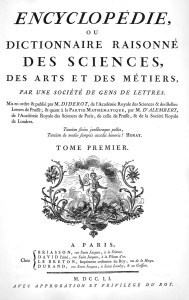Founded on logic, reason, and the spirit of critical enquiry, the mid-18th century publication of the Encyclopédie, ou dictionnaire raisonné des sciences, des arts et des métiers (Encyclopedia, or a Systematic Dictionary of the Sciences, Arts, and Crafts) was the culmination of everything that the Age of Enlightenment stood for.
 Diderot by Louis-Michel van Loo, 1767
Diderot by Louis-Michel van Loo, 1767
Inspired by Francis Bacon’s idea of the systematic classification of knowledge, Denis Diderot, who edited the Encyclopédie, claimed that it was a collection of “all the knowledge scattered over the face of the earth.” He hoped that it would dispel human ignorance and transform society. To aid in this monumental endeavor, Diderot enlisted some of the greatest minds of the French Enlightenment to contribute to the Encyclopédie.
 Voltaire by Nicolas de Largillière.
Voltaire by Nicolas de Largillière.
Voltaire wrote on matters of history, literature, nature, philosophy and art.
 Jean-Jacques Rousseau by Maurice Quentin de La Tour, 1753.
Jean-Jacques Rousseau by Maurice Quentin de La Tour, 1753.
Jean-Jacques Rousseau wrote on music and political theory.
 Madame de Pompadour encouraged Diderot in his publication of the first two volumes of the Encyclopédie. Portrait by Maurice Quentin de La Tour, 1755 (Louvre Museum).
Madame de Pompadour encouraged Diderot in his publication of the first two volumes of the Encyclopédie. Portrait by Maurice Quentin de La Tour, 1755 (Louvre Museum).
Notably, there were no women contributors to the Encyclopédie and, in the entire text, no woman who had made a contribution to history was mentioned.
 “Figurative system of human knowledge,” organized into Memory, Reason, and Imagination. Encyclopédie, ou dictionnaire raisonné des sciences, des arts et des métiers.
“Figurative system of human knowledge,” organized into Memory, Reason, and Imagination. Encyclopédie, ou dictionnaire raisonné des sciences, des arts et des métiers.
The Encyclopédie came under “repeated attack as a repository of skepticism, atheism, and sedition.” The contributors were labeled “encyclopédistes” and encyclopaedism became a synonym for a refusal to accept anything uncritically.
 Frontispiece of Volume I, Teyler’s Museum, Netherlands. Encyclopédie, ou dictionnaire raisonné des sciences, des arts et des métiers.
Frontispiece of Volume I, Teyler’s Museum, Netherlands. Encyclopédie, ou dictionnaire raisonné des sciences, des arts et des métiers.
The first volume was published in 1751. Twenty-seven more volumes followed, for a total of seventeen volumes of text and eleven volumes of plates. In 1759, publication was suspended by the French Government and the Encyclopédie was banned. Diderot continued working in secret on the remaining volumes, which were finally published in 1765 and 1766.
Later, many would cite the Encyclopédie as one of the contributing factors to the French Revolution.
The complete collection of plates from the Encyclopédie as well as translations of many of the text articles can be viewed online at The University of Michigan Library. The plates can also be viewed at the ARTFL Encyclopédie Project at the University of Chicago. I encourage you to visit their collections. In the meanwhile, here are a sampling of Encyclopédie plates to whet your appetite…
 Saddle and Coach Maker, Barouche. Encyclopédie, ou dictionnaire raisonné des sciences, des arts et des métiers.
Saddle and Coach Maker, Barouche. Encyclopédie, ou dictionnaire raisonné des sciences, des arts et des métiers.
 Saddle and Coach Maker, Equipment of a Saddle Horse. Encyclopédie, ou dictionnaire raisonné des sciences, des arts et des métiers.
Saddle and Coach Maker, Equipment of a Saddle Horse. Encyclopédie, ou dictionnaire raisonné des sciences, des arts et des métiers.
 Saddle and Coach Maker, Saddles. Encyclopédie, ou dictionnaire raisonné des sciences, des arts et des métiers.
Saddle and Coach Maker, Saddles. Encyclopédie, ou dictionnaire raisonné des sciences, des arts et des métiers.
 Natural History, Insects. Encyclopédie, ou dictionnaire raisonné des sciences, des arts et des métiers.
Natural History, Insects. Encyclopédie, ou dictionnaire raisonné des sciences, des arts et des métiers.
 Natural History, Lion and Tiger. Encyclopédie, ou dictionnaire raisonné des sciences, des arts et des métiers.
Natural History, Lion and Tiger. Encyclopédie, ou dictionnaire raisonné des sciences, des arts et des métiers.
 Bookbinding. Encyclopédie, ou dictionnaire raisonné des sciences, des arts et des métiers.
Bookbinding. Encyclopédie, ou dictionnaire raisonné des sciences, des arts et des métiers.
 Writing, The Art of Writing. Encyclopédie, ou dictionnaire raisonné des sciences, des arts et des métiers.
Writing, The Art of Writing. Encyclopédie, ou dictionnaire raisonné des sciences, des arts et des métiers.
 Confectioner, Chocolate and Cheese Moulds. Encyclopédie, ou dictionnaire raisonné des sciences, des arts et des métiers.
Confectioner, Chocolate and Cheese Moulds. Encyclopédie, ou dictionnaire raisonné des sciences, des arts et des métiers.
 Music. Encyclopédie, ou dictionnaire raisonné des sciences, des arts et des métiers.
Music. Encyclopédie, ou dictionnaire raisonné des sciences, des arts et des métiers.
Top photo: Title Page to Volume I of the Paris Edition, Encyclopédie, ou dictionnaire raisonné des sciences, des arts et des métiers.
This article originally appeared on MiMiMatthews.com and is reprinted here with permission.
More from BUST
These Carpet Bags Were Essential For Any Victorian Lady’s Travel
Literature Meets Litigation: How Charles Dickens’s “Bleak” Telling Of Victorian Law Led To Reform
War Letters Teach Us More About History Than Any Textbook Can


